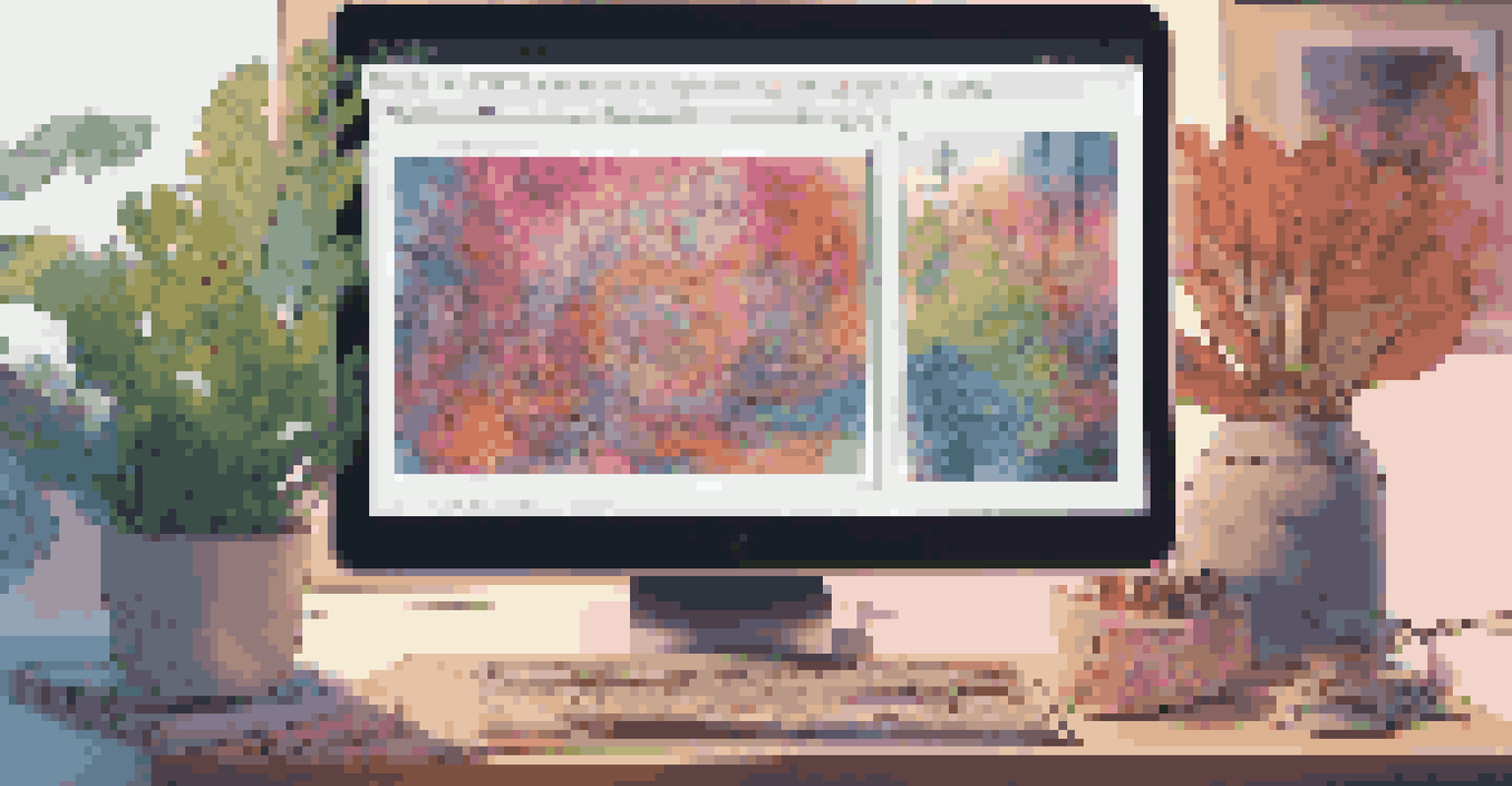Art, Consumerism, and the Environment: Sustainable Practices

The Intersection of Art and Consumerism in Today’s World
Art and consumerism often go hand in hand, shaping cultural landscapes and influencing societal values. Every purchase we make can be seen as an expression of personal identity, often driven by artistic expressions. From fashion to home decor, art plays a crucial role in consumer choices, igniting passions and sparking trends.
Art is not freedom from discipline, but disciplined freedom.
However, this relationship can lead to overconsumption, where the allure of new artistic products fuels a cycle of buying and discarding. This cycle not only clutters our lives but also has serious environmental implications, contributing to wastefulness and ecological degradation. Understanding this connection sets the stage for exploring more sustainable practices.
As we navigate this complex relationship, it's essential to recognize the power art holds in both driving consumerism and advocating for change. By reimagining how we engage with art and the products we purchase, we can foster a culture that values sustainability without sacrificing creativity.
Understanding the Environmental Impact of Art Production
The production of art, while often celebrated, can have a significant environmental footprint. Consider the resources required to create traditional art materials like paints, canvases, and sculptures. Many of these materials are derived from non-renewable sources, and their production processes can generate considerable waste and pollution.

Furthermore, the transportation of art and art supplies contributes to carbon emissions, impacting our planet's health. As artists and consumers, we must reflect on the materials we use and their environmental implications. Shifting toward eco-friendly alternatives can help mitigate these effects and promote a healthier planet.
Art Drives Consumer Sustainability
The relationship between art and consumerism can foster a culture that values sustainable practices while still celebrating creativity.
By choosing sustainable materials, artists can not only reduce their environmental impact but also inspire others to follow suit. This shift towards eco-conscious art production opens the door to innovative practices that celebrate creativity while honoring our commitment to the environment.
Sustainable Practices in Contemporary Art
Contemporary artists are increasingly exploring sustainable practices, incorporating recycled materials and eco-friendly techniques into their work. By repurposing discarded items, they are not only reducing waste but also giving new life to materials that would otherwise end up in landfills. This creative reuse challenges traditional notions of art and beauty, making sustainability an integral part of the artistic process.
The greatest threat to our planet is the belief that someone else will save it.
For example, artists are embracing natural pigments and organic materials, producing artworks that minimize harm to the environment. This movement goes beyond aesthetics; it reflects a commitment to sustainability that resonates with conscious consumers. As a result, art becomes a powerful medium for raising awareness about environmental issues.
Moreover, galleries and exhibitions are also adopting sustainable practices, such as using energy-efficient lighting and sustainable display materials. These efforts create a ripple effect, encouraging artists and audiences to consider their own environmental impact while engaging with art.
The Role of Consumers in Promoting Sustainable Art
As consumers, we hold significant power in shaping the art market and influencing sustainable practices. By supporting artists who prioritize eco-friendly materials and methods, we send a strong message about our values. This conscious consumerism can drive demand for sustainable art, encouraging more creators to adopt environmentally responsible practices.
Additionally, being informed about the lifecycle of art products can help consumers make better choices. Understanding where materials come from and how they are produced allows us to support brands that align with our sustainability goals. Every purchase becomes an opportunity to advocate for the environment.
Eco-Friendly Art Production Matters
The environmental impact of traditional art materials urges a shift toward sustainable practices in both production and consumption.
Ultimately, consumers and artists can collaborate to foster a culture of sustainability in the art world. By prioritizing eco-conscious choices, we can create a marketplace that values both creativity and environmental stewardship.
Community Initiatives Supporting Sustainable Art Practices
Many communities are stepping up to promote sustainable art initiatives, creating platforms for artists and consumers to connect. Local art fairs and workshops often feature eco-friendly practices, showcasing artists who prioritize sustainability. These gatherings not only highlight innovative works but also foster a sense of community around shared values.
Additionally, educational programs are emerging to teach aspiring artists about sustainable materials and techniques. By providing resources and support, these initiatives empower the next generation of creators to make environmentally conscious choices. This grassroots movement can have a lasting impact on the art landscape.
Community involvement is key; when we come together to support sustainable art, we create a collective voice that can influence broader change. The more we engage with and promote these initiatives, the more we can reshape the art world into a space that champions sustainability.
The Influence of Digital Art on Sustainability
Digital art presents a unique opportunity to reduce the environmental impact associated with traditional art forms. Since digital creations require no physical materials, they minimize waste and resource consumption. This shift has opened the door for artists to explore new mediums without the ecological footprint of paint, paper, or canvas.
Moreover, the rise of digital platforms allows artists to reach wider audiences without the need for physical exhibitions. Online galleries and virtual showcases eliminate the need for transportation, further reducing carbon emissions. This accessibility can democratize art, making it easier for consumers to engage with and support sustainable practices.
Community Initiatives Promote Change
Local art initiatives and education empower communities to support sustainable art practices and influence broader environmental change.
However, it’s important to consider the environmental cost of technology itself. As digital art gains popularity, we must also promote responsible consumption of devices and energy-efficient practices in the digital art community. Balancing innovation with sustainability is key to ensuring a brighter future for both art and the environment.
Future Trends: Art, Consumerism, and Sustainability
The future of art, consumerism, and sustainability is bright, with trends pointing toward a more eco-conscious approach. As awareness of environmental issues grows, artists and consumers alike are increasingly prioritizing sustainable practices. This collective shift is likely to redefine how we view art and its role in society.
Expect to see more collaborations between artists and environmental organizations, creating projects that highlight sustainability themes. These partnerships can amplify the message of environmental stewardship and inspire change on a larger scale. Furthermore, as technology advances, innovative solutions will continue to emerge, making sustainable practices more accessible.

Ultimately, the future of art will depend on our commitment to integrating sustainability into every aspect of the creative process. By embracing this vision, we can create a vibrant art world that not only reflects our values but also contributes positively to our planet.